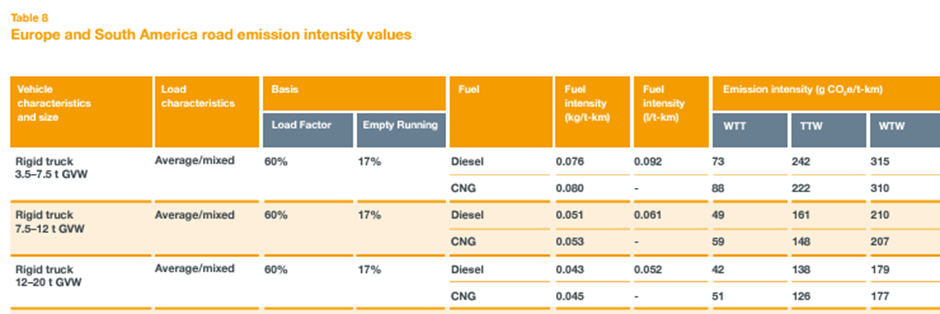Lorem ipsum dolor sit amet, consectetur adipiscing elit. Curabitur eleifend tortor nec augue pretium


Within the logistics and supply chain industry, comparing scope 3 emissions for multimodal logistics can be like comparing apples and oranges.
The challenges arise from the diverse nature of the industry, with carriers, logistics service providers, ports and owned fleets each bringing their own unique part of the puzzle – or fruit basket.
When a UK customer orders, for example, a car part from a supplier in China, it starts its journey from the warehouse in a collection van that takes it to a regional sorting centre. Here, it is moved onto a line-haul vehicle for the trunking route to the port, where it is loaded onto a ship.
Once at the destination, the process is reversed with the trunking route and delivery van. Throughout this process, the package passes through several transit points (warehouses, ports, distribution centres, etc). Each segment and stop has distinct emissions factors, influenced by the type of fuel used and the specific route taken. Collectively, these are known as transport chain elements (TCEs), covered by the ISO 14083 standard.
As discussed, the TCEs in multimodal logistics can be extremely variable, with each element of the journey contributing different emissions. The collection and delivery van might use diesel, the haul lorry may be on hydrotreated vegetable oil and the cargo ship on heavy fuel oil. Each of these fuel types has a unique emissions profile, complicating the task of accurately calculating the total emissions for the journey.
Furthermore, the efficiency of the route – including the empty leg run where the vehicle returns to its depot, the type of vehicle used, and even the vehicle load capacity can all influence the emissions generated.

Collecting the apples and oranges
The challenge in calculating multimodal scope 3 emissions lies in how to collect the data consistently and comprehensively. Each respective TCE is rarely with the same organisation, leading to difficulties in obtaining the data.
Reporting standards demand transparency, yet providers often supply incomplete or inconsistent data, especially when road journeys on the haul route are independent or owner-driver models.
This often leaves it down to the supplier to arrive at a comprehensive figure that can stand up to scrutiny when reporting their carbon footprint.
Scope 3 emissions under the GHG protocol
The greenhouse gas (GHG) protocol categorises scope 3 emissions into several different baskets (purchased goods and services, business travel, etc). Specifically, for multimodal logistics, they can be classified into being upstream or downstream transport and distribution for reporting reasons. In logistics terms, this can be deliveries or returns, or even intercompany shipments between warehouses or groups.
For the example of shipments between group companies, it is important to investigate any potential double reporting – one company dispatching goods to another will calculate the scope 3 emissions associated with the move, while the receiver will calculate the emissions from receiving it, both potentially reporting the same emissions to their overall group total.
The GLEC framework
One method that is gaining traction within the logistics industry as a collaborative approach to calculating emissions is the Global Logistics Emissions Council (GLEC) framework, developed by the Smart Freight Centre. It aims to standardise emissions calculation and reporting across different modes of transport and logistics activities. This framework provides a detailed methodology for calculating logistics emissions, including default values for cases where primary data is unavailable. It also helps ensure consistency and comparability in emissions reporting, making it easier for companies to meet regulatory requirements and improve their sustainability performance.

ISO 14083
The GLEC framework has laid the foundation for a new ISO standard – ISO 14083:2023 greenhouse gases — quantification and reporting of greenhouse gas emissions arising from transport chain operations. The standard develops the work by the Smart Freight Centre and its GLEC framework into a universally accepted methodology for calculating and reporting logistics emissions. It aims to give the same level of credence and global acceptance to logistics emissions reporting as ISO 14001:2015 does for environmental management systems. By standardising the approach to emissions calculation and reporting, ISO 14083 helps companies demonstrate their commitment to sustainability and improve their environmental performance.
Building a fruit basket with a TMS
With a comprehensive transport management system (TMS), the task of collecting all the relevant pieces of information and data tables to calculate the scope 3 emissions is made easier by the comprehensive tracking and analysis the TMS performs in its purpose of managing the logistics from booking, tracking and delivery.
By collecting detailed data on transportation logistics, such as fuel consumption, vehicle types, distances travelled and shipment frequencies, a TMS enables precise measurement of the Scope 3 emissions associated with third-party logistics and transportation services. This capability allows organisations using the TMS to integrate the calculation of scope 3 emissions easily – in effect, representing a fruit basket containing all the apples and oranges.
The task of comparing and collecting the scope 3 emissions associated with multimodal logistics is a complex but essential need in striving for net zero. The diverse elements of the transport chain and the multitude of data sources involved make accurate emissions calculation challenging. However, through collaboration between stakeholders and the adoption of standardised frameworks such as the GLEC’s and ISO 14083, companies can improve the accuracy and reliability of their emissions reporting. These efforts are crucial for enhancing transparency, meeting regulatory requirements and driving progress towards a more sustainable future in logistics and supply chain management.
John Murray is head of sustainability at CCL Logistics & Technology
References: -
Smart Freight Centre (SFC) Global Logistics Emissions Council (GLEC) Framework 3.0
https://www.smartfreightcentre.org/documents/328/GLEC_FRAMEWORK_v3_UPDATED_02_04_24.pdf
ISO standard – ISO 14083:2023 Greenhouse gases — Quantification and reporting of greenhouse gas emissions arising from transport chain operations
https://www.iso.org/standard/78864.html
Greenhouse Gas Protocol Corporate Value Chain (Scope 3) Standard
https://ghgprotocol.org/corporate-value-chain-scope-3-standard
Image credit: Shutterstock